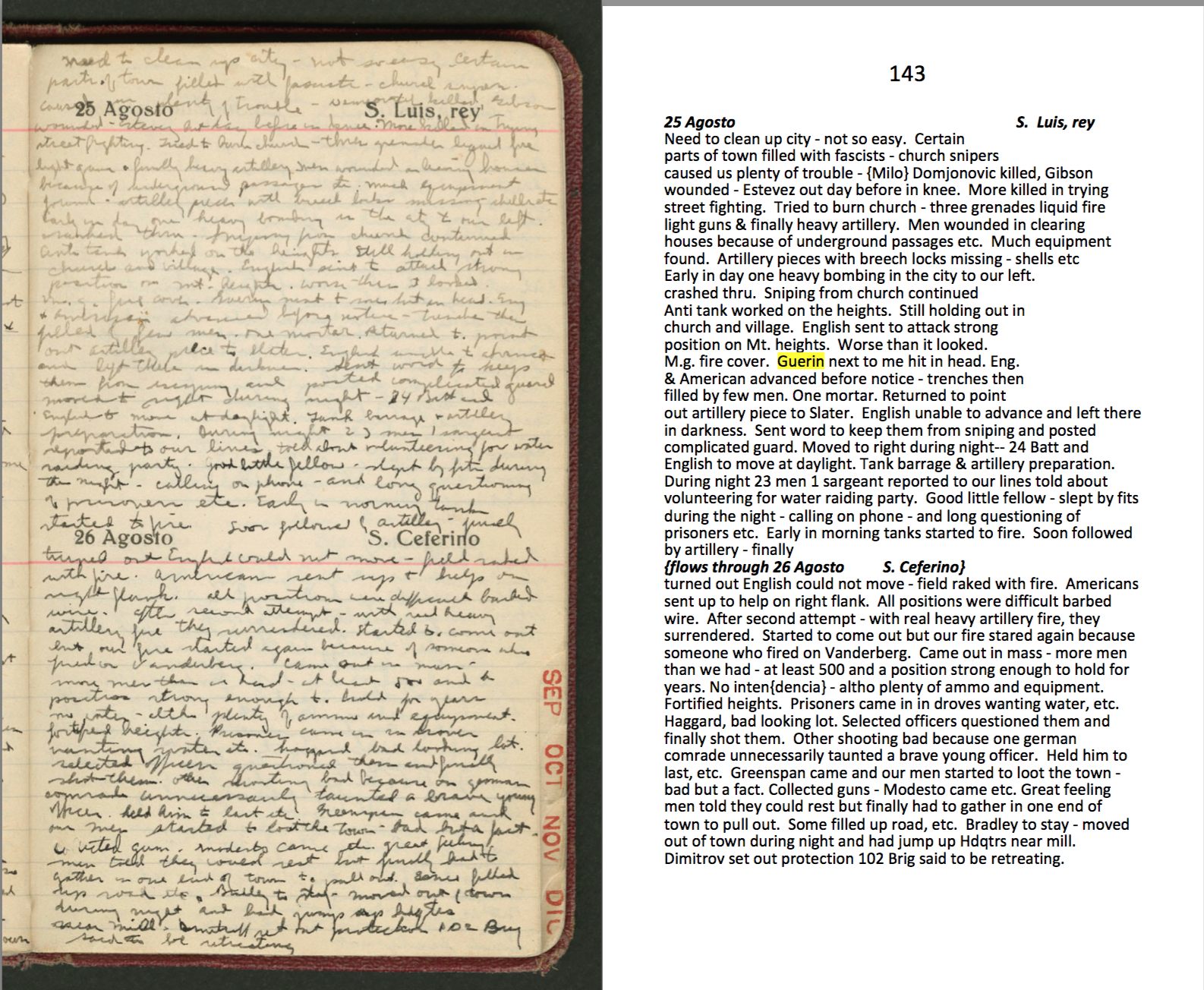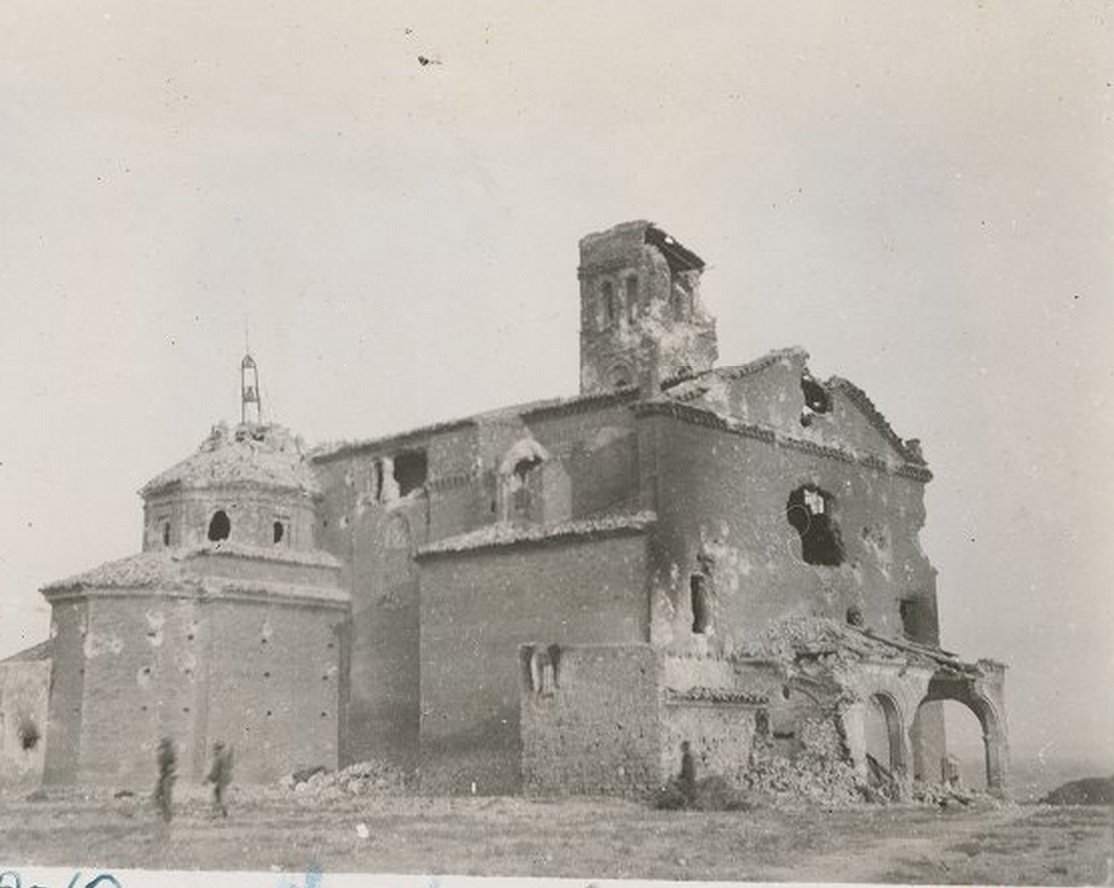
Merriman’s diary for these days has to be read in tandem with the 23-24 Agosto pages. He straightens out some of the time line that his excitement and enthusiasm of the 24th has clouded for us. On the 25th, it was clear that while Quinto was in the hands of the International Brigades, they held many trapped Fascists troops in the town, in the church, and on the heights of Purburell. Merriman went into town with a group of troops and Maurice Constant’s memory of the event was given in yesterday’s post. In the fighting to take the church, Milo Domjonovic was killed and “Gibson” was wounded. This is likely Canadian Patrick Gibson since there is no Gibson in the Lincoln Brigade. “Estevez” is likely a Spanish comrade.

Merriman reports briefly on the street to street fighting. Many IB were killed going from house to house as the basements had been linked in town and when a house was attacked, the defenders would move to another. The church was a particular problem since it held the high ground above the town and from the steeple, one had a field of fire on the cemetery and town. The photo on the right shows the church after the IB’s finished with it and took their prisoners. Yesterday’s post shows it as it stands today.
Merriman says “Guerin next to me hit in the head”. From Maurice Constant’s story given yesterday makes us wonder if Merriman got the name wrong and confused his Canadians. Constant was the one who was shot in the head. Another Staff member, “Gede¹” was killed and perhaps this is the name Merriman was searching for. In trying to take the church, Tom Wintringham is also shot and this wound will finally send him back to England.
Merriman went to the cemetery after noon and ordered the British who were in reserve to take Purburell Hill. He admits to his diary that it was worse than it looked. No covering artillery or tank fire was available since it was expected that the hill was only lightly defended³. Peter Daly, the British Commander, led the charge and was shot almost immediately in the stomach by a machine gun. He would die on September 5, 1937, in Benicassim Hospital. The Canadian section leader, Tommy Lyons, was wounded in the head.³ The Irishman Paddy O’Daire took over command. The Book of the XVth Brigade¹ relates the story that the Fascist aviation actually bombed their own troops on Purburell Hill. The British go up on the 25th and get pinned down in trenches as the sun is going down. The British make the trenches on the hill but light runs out and they have to stay the night in the trenches. Merriman sets out a complicated sentry scheme to keep the Fascists on the hill and tells the British not to snipe at them (which would give their positions away).
Merriman says that a number of men made a sortie to raid water and that the Sergeant in charge of the maneuver was a “Good little fellow”. Landis attributes this to Larry O’Toole and Melvin Anderson of the Americans who cut the pipeline feeding the water supplies to Purburell Hill. This could be the most significant attack of the entire battle. In the attempt to get water overnight on the 25th and 26th, about a dozen fascists were captured who were also out trying to obtain water. These are the men that Merriman spent the night of the 25th interrogating. At this time, the Brigade knew that a large number of men were on the hill, but that they were in a desperate state because of the lack of water.
Steve Nelson tells the story:
That same evening, the guards brought in a little Fascist sergeant, who was grinning and happy to be a prisoner. He stood before Bob Merriman. “Him and twenty-nine others”, said the guard. “They come in with their hands up just now”.
“They sent us for water, to the river”, the sergeant offered. “I was leader. So I led them here”.
“What were you doing with the fascists?”
“I was an observer and mapper”
“How did it happen that they sent you for water?”
“I volunteered. I figured this was my chance to get away”.
“Why were you with the fascists?”
“Conscripted. What would you? It was enlist or be shot.”
“I see … How many men on the hill?”
“About a thousand. Two hundred are wounded, forty-five dead. The airplanes yesterday killed all the artillery crew, and put the guns out of commission… Tell me, were they your planes?”
“No. They bombed you because they thought we had already taken the hill. Look, we’ll ask the questions. How’s the morale?”
“The officers shot six men yesterday. Does that tell you?… Today we heard many broadcasts that a relief column was approaching, to hold out all all costs. But there is no water. That’s the main trouble–no water.”
“Is that the chief worry of the officers?”
“Yes. That, and your tanks and planes; they have no anti-tank or anti-aircraft left.”
“You say you’re a mapper. Draw a sketch of the whole position on the hill. Mark in the ammunition dump, radio post, command, machine gun nests, everything.”
When the map was finished, he sent the sergeant out, and had another prisoner brought in. With him, he checked the information supplied by the sergeant. Everything jibed. Merriman phoned the tank and artillery commands and other units, giving the men orders.”²
From Merriman’s diary, it appears that the tank, antitank, and artillery barrage on the hill started on the 26th of August. This softening up was followed by an assault which did not succeed. Merriman brought the Americans up on another flank of the hill to assist in the assault. This group was led by Charlie Nusser, #1 Company commander, Sam Gonshak, his adjutant, and David “Mooch” Engels, the commissar. The battle for Purburell Hill lasted about five hours and was not without drama. At one point, Italian Caproni aircraft flew over and bombed their own lines on the hill. Thinking that this was Republican aircraft, white flags went up and the Brigades advanced thinking they had taken the hill. When the Fascists realized that these were their aircraft and that they were returning for other strafing runs, they hauled down the flags and began firing again. In the meantime, however, the Brigades significantly advanced up the hill without fire.
After a late afternoon precision artillery and anti-tank barrage led by Hugh Slater’s Britons, again white flags went up. As Merriman relates in the diary, however, some fascists fired on Vanderberghe and the white flags again came down and shooting commenced again. Paddy O’Daire’s British battalion had reached the Fascist trenches by that point and yelling “Charge the trench”, the Brigadistas saw hands go up and the Fascists yelled “Agua. Agua”. Clearly without water in the August sun, they were dying of thirst.

The Fascist troops surrendered. One German and one White Russian killed themselves. Felix Kusman related to Art Landis in his taped interview 30 years later:
The sun is going down. The first couple of positions we occupy with no opposition–lots of wounded — lots of dead — lots of prisoners. We ordered the prisoners to put their arms down and to take the wounded to the center of the hill. And, at the center we find a command post for the officers and Falangists. There had been women there too, officers’ wives and others. The place was surrounded by machine-gun nests, but they are empty now, as is the command bunker itself. The officers have retreated to the northeast section of the hill and are putting up a last resistance against the Spaniards of the 24th Battalion. They are wiped out. We continue. At one point we see a White Russian officer. Larry O’Toole and I approach him. He is screaming in Russian: “Red Pigs! Red Pigs!” Then in Spanish : “If you come any closer I’ll shoot!”. O’Toole yells back: “Go ahead and shoot, you bastard. If you don’t, I will!” He has his gun in his hand and he blows his brains out, I take his gun and a sword and a Russian Bible from his body”.¹

The photo on the left is of the Fascist officers in the bunkers planning the defense. Most were killed and many of those who were captured were executed. Merriman says in excess of 500 prisoners were taken. It is hard to believe that all were shot, although taking of prisoners did not guarantee them Geneva Convention rights. Merriman says the number of prisoners exceeded the number of International Brigades attackers.

Merriman relates the dirtier side of war in this passage. Prisoners were shot. A German Brigader taunted a Spanish officer and then shot him. The Brigade looted the town. Marion Greenspan came up to Quinto and after that the men had their weapons taken from them, perhaps to cut down on retribution or attacks on civilians. Juan Modesto, head of the Division, comes to Quinto to observe the victory and everyone is justifiably proud of their accomplishments. While they were given a hint that they could rest for a while, the need to get quickly to Zaragoza means that the victory celebration would be short lived. The element of surprise is now gone and the Fascists will be countering the assault so the XVth Brigade needs to keep moving northward. They gather on the edge of town and are told they need to move up. The Dimitrovs will lead the protection units on the move and Merriman is told that the 102nd Brigade is retreating. The 102nd Brigada Mixta crossed the Ebro at Pina del Ebro (between Quinto and Fuentes del Ebro) and took the town (thanks to Alan Warren for the history). If they were retreating south towards Quinto this would slow the advance towards Zaragoza.
_______________________________
¹ Art Landis, The Abraham Lincoln Brigade, ibid. pp 261-280.
² Steve Nelson, The Volunteers, ibid, p 179.
³ Book of the XVth Brigade, ibid., pp 247-256.
